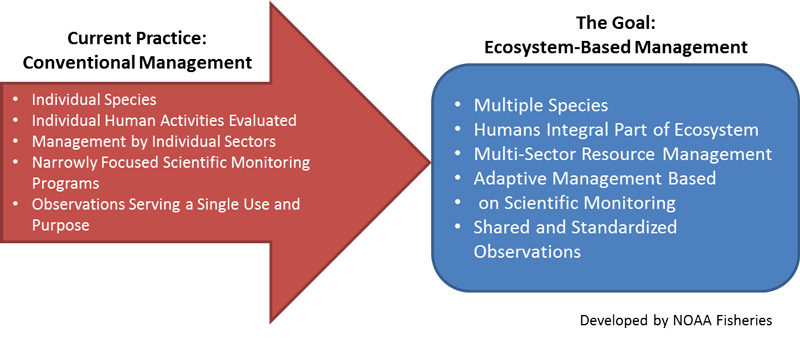5.6 Ecosystem-Based Management (EBM)
Ecosystem-Based Management (EBM) is an integrated approach to conserve ecosystems that includes components of environmental protection, the social community that interacts with the ecosystem, and economic considerations (Fig.1_Ses5.6_NOAA).

Marine management typically has focused on a single species, sector, activity or concern, whereas EBM takes into account the cumulative impacts and interactions of different human activities. Among the variables that need to be taken into account to fully understand the EBM approach there are the population abundance and structure, life history traits, competition with other species, where the stock is placed in the local food web, tidal fluctuations, salinity patterns and anthropogenic influences.
For the marine environment, the EBM goal is to ensure sustainable ecosystems, thus protecting the goods and services they provide for future generations. As we have seen in previous sections, there are many services provided by marine ecosystems that are declining as a result of anthropogenic impacts. Loss of biodiversity is an example of how cumulative impacts can influence on an ecosystem. Overfishing, nutrient and chemical pollution from land runoff, coastal development, bycatch, mining and other human activities all contribute to the loss of biodiversity and therefore the degradation of the ecosystem. The EBM evaluates the interactions of the organisms by monitoring the ecosystem as a whole, consequently it could be better able to monitor the biodiversity than other approaches.An example of EBM is the widely adopted ecosystem approach to fishery management (EAFM) which is consistent with the concept of sustainable development (Fig.2_Ses5.6_NOAA).

The main purpose of EAFM is to plan, develop and manage fishery to meet the need of today’s societies without compromising the needs of the future generations. Many of EAFM actions focus on mitigating the environmental impacts of fishing on a case-by-case basis. The Turtle Excluder Device or TED is a device that allows captured sea turtle to escape when caught in a fisherman net (Fig.3 & 4_Ses5.6_Wikimedia commons).


This device is not only a way to stop turtles to be killed as bycatches, but also a first step to include the environment in fishery management.
There is an urgent need to improve the management of the ecosystems in decline, focusing on the diverse benefits provided by marine systems, rather than on single ecosystem services, to ensure a sustainable future. Human communities rely on marine ecosystem for important resources, but without an integrated approach and management these ecosystems are likely to deteriorate. For example, one goal could be sustainable fishery while incorporating the impacts of other factors on that resource. An ecosystem-based model can improve not only the resource being managed, but also different ones linked to it.

